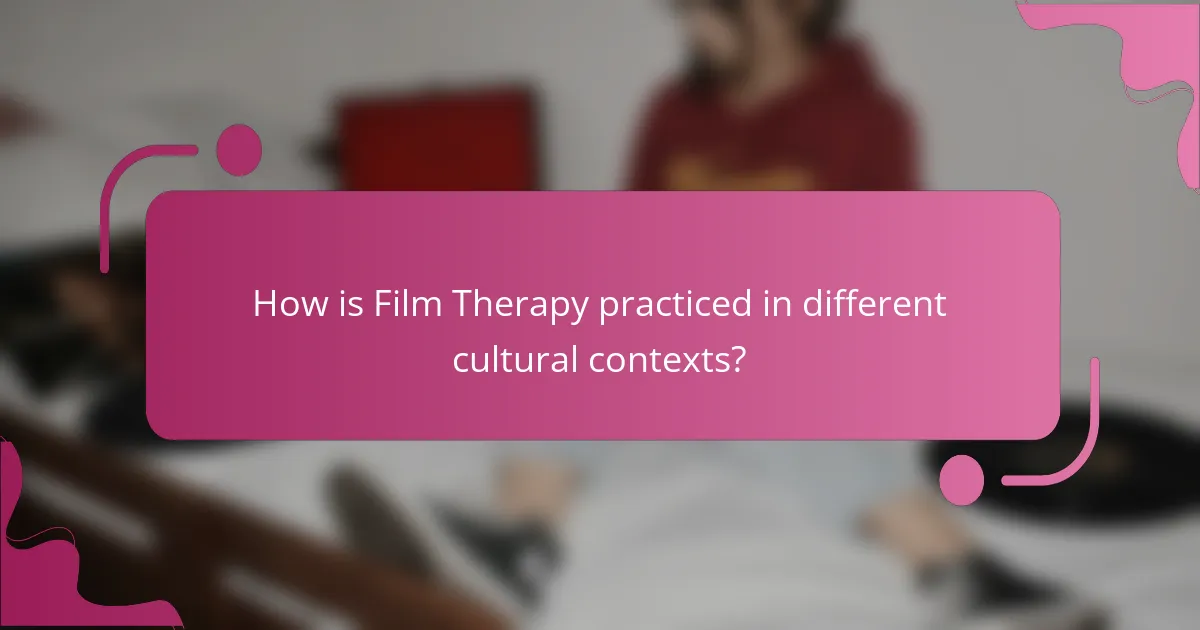Film therapy offers significant benefits for emotional healing and personal growth. It promotes self-reflection, emotional catharsis, and narrative engagement, allowing individuals to connect deeply with their feelings. This approach emphasizes personalized film selection, enhancing the therapeutic process. Additionally, film therapy finds application across various settings, including clinical, educational, and corporate environments, facilitating discussions and fostering empathy.

What are the core principles of Film Therapy?
Film therapy utilizes cinematic experiences to promote emotional healing and personal growth. Its core principles include self-reflection, emotional catharsis, and narrative engagement.
Self-reflection allows individuals to explore their feelings and thoughts through characters and storylines. Emotional catharsis occurs as viewers connect with on-screen experiences, facilitating the release of pent-up emotions. Narrative engagement encourages personal connections to the film’s themes, fostering insight and personal development.
Additionally, film therapy emphasizes the importance of choice in viewing, allowing individuals to select films that resonate with their unique experiences. This personalization enhances the therapeutic process, making it more effective in addressing emotional challenges.
How does Film Therapy facilitate emotional healing?
Film therapy facilitates emotional healing by using cinematic narratives to evoke feelings and promote self-reflection. It allows individuals to connect with characters and stories, fostering empathy and understanding of their own emotions. By engaging with film, participants can explore personal experiences and gain insights into their emotional challenges. This therapeutic approach encourages dialogue about feelings and experiences, enhancing emotional awareness and resilience. Additionally, film therapy can provide a safe space for processing trauma and developing coping strategies, ultimately supporting personal growth.
Which psychological theories underpin Film Therapy?
Film therapy is underpinned by psychological theories such as narrative therapy, cognitive-behavioral therapy (CBT), and psychodynamic theory. These frameworks emphasize storytelling, cognitive restructuring, and the exploration of unconscious processes, respectively.
Narrative therapy focuses on the individual’s personal narrative, allowing clients to reinterpret their experiences through film. Cognitive-behavioral therapy helps individuals identify and change negative thought patterns, which can be facilitated by film characters and plots. Psychodynamic theory encourages exploration of emotions and motivations, often reflected in cinematic narratives.
Research indicates that film therapy can enhance emotional processing and foster personal growth. By engaging with films, individuals can gain insights into their own lives, leading to improved mental health outcomes.

What benefits can individuals expect from Film Therapy?
Film therapy offers individuals emotional healing and personal growth through enhanced self-awareness, improved emotional regulation, and increased empathy. Participants often experience catharsis, gaining insights into their feelings and behaviors. This therapeutic approach can also foster connection with others by sharing experiences and perspectives. Additionally, film therapy can serve as a unique tool for processing trauma, helping individuals confront and navigate difficult emotions in a safe environment.
How does Film Therapy contribute to personal growth?
Film therapy significantly contributes to personal growth by facilitating emotional healing and self-discovery. It uses cinematic narratives to help individuals process emotions, gain insights, and develop coping mechanisms. Participants often report increased empathy and improved emotional regulation as they relate to characters and stories.
Additionally, film therapy encourages reflection on personal experiences, allowing individuals to confront and reframe their narratives. This process can lead to enhanced self-awareness and a greater understanding of one’s emotions and behaviors. By engaging with diverse perspectives, individuals can cultivate resilience and foster personal transformation.
Overall, film therapy serves as a powerful tool for emotional healing, enabling individuals to navigate their personal journeys more effectively.
In what ways does Film Therapy enhance self-awareness?
Film therapy enhances self-awareness by allowing individuals to explore emotions and experiences through cinematic narratives. It fosters reflection on personal issues and encourages emotional expression. Viewing characters’ journeys can reveal insights about one’s own feelings, motivations, and behaviors. As a result, participants often gain a deeper understanding of themselves and their relationships. This therapeutic approach utilizes the power of storytelling to facilitate personal growth and emotional healing.
Which emotional challenges can Film Therapy address?
Film therapy can effectively address emotional challenges such as anxiety, depression, trauma, and relationship issues. It provides a safe space for individuals to explore their feelings through cinematic narratives. This therapeutic approach encourages personal reflection, emotional expression, and insights into behavioral patterns. As a result, participants often experience enhanced emotional resilience and personal growth.

How is Film Therapy practiced in different cultural contexts?
Film therapy is practiced differently across cultures, reflecting diverse values and beliefs. In Western contexts, it often emphasizes individual emotional healing and personal growth through self-reflection and narrative analysis. Practitioners may select films that resonate with clients’ experiences, promoting catharsis and insight.
In contrast, Eastern cultures may integrate community and collective experiences into film therapy. Here, films serve as tools for group discussions, fostering shared understanding and emotional support. The focus often extends beyond the individual, emphasizing relational healing and cultural identity.
Cultural narratives influence film selection and interpretation in all contexts. For example, films portraying resilience in adversity may resonate more in cultures valuing community strength. Conversely, narratives emphasizing personal triumph may be favored in individualistic societies.
Overall, film therapy adapts to cultural nuances, enhancing its effectiveness for emotional healing and personal growth across different settings.
What role do regional film selections play in Film Therapy?
Regional film selections play a crucial role in Film Therapy by enhancing emotional connection and cultural relevance. These films often reflect local narratives, allowing individuals to see their experiences represented on screen. This representation fosters a sense of belonging and validation. Moreover, regional films can address specific emotional issues relevant to the audience, promoting deeper engagement and personal reflection. By incorporating diverse cultural perspectives, Film Therapy can facilitate broader emotional healing and personal growth.
How do local therapists integrate cultural narratives in Film Therapy?
Local therapists integrate cultural narratives in Film Therapy by using films that resonate with clients’ backgrounds. This approach enhances emotional healing and personal growth by validating individual experiences. Culturally relevant films can evoke deeper connections and reflections, facilitating discussions about identity and shared experiences. By incorporating diverse narratives, therapists create a safe space for clients to explore their emotions and gain insights into their personal journeys. This method not only fosters understanding but also promotes resilience and empowerment through storytelling.

What are some unique approaches within Film Therapy?
Film therapy employs unique approaches such as narrative therapy, where clients reinterpret their life stories through films. Another method is the use of specific film genres to evoke emotional responses, aiding in self-discovery. Additionally, film therapy can incorporate group discussions, fostering shared experiences and insights. These approaches enhance emotional healing and personal growth by connecting individuals with relatable characters and stories.
How does the use of documentary films differ from narrative films in therapy?
Documentary films in therapy provide real-life insights, while narrative films offer fictional storytelling. Documentaries facilitate emotional connection through authentic experiences, enhancing empathy. Narrative films allow exploration of personal issues in a safe context, promoting self-reflection. Both forms serve unique therapeutic purposes, aiding emotional healing and personal growth.
Which innovative techniques are emerging in Film Therapy?
Emerging techniques in Film Therapy include interactive storytelling, virtual reality integration, and personalized film selections. These methods enhance emotional engagement and foster deeper connections with narratives. Interactive storytelling allows participants to influence plot outcomes, promoting self-reflection. Virtual reality immerses users in therapeutic scenarios, enhancing emotional responses. Personalized selections tailor content to individual experiences, maximizing relevance and impact. These innovations support emotional healing and personal growth by creating more engaging therapeutic environments.

What are the practical applications of Film Therapy in various settings?
Film therapy has diverse practical applications across various settings, enhancing emotional healing and personal growth. In clinical environments, therapists use films to facilitate discussions about emotions and experiences, helping clients process trauma. Educational settings utilize film therapy to promote empathy and understanding among students, encouraging them to engage with complex social issues. Community centers may implement film therapy workshops to foster connection and dialogue within groups, aiding in collective healing. Additionally, corporate environments explore film therapy for team-building and stress relief, enhancing workplace morale and communication. Each setting leverages the unique attributes of film to create impactful therapeutic experiences.
How is Film Therapy utilized in educational environments?
Film therapy is effectively utilized in educational environments to promote emotional healing and personal growth. It provides students with a safe space to explore their feelings through cinematic narratives. This method enhances empathy, self-awareness, and communication skills.
In classrooms, film therapy can be integrated into curricula to address mental health issues. For example, films can stimulate discussions about emotions and relationships, allowing students to process their experiences. Research shows that this approach can lead to improved emotional regulation and resilience among students.
Additionally, film therapy caters to diverse learning styles. Visual storytelling engages students who may struggle with traditional educational methods. By connecting with characters and stories, students gain insights into their own lives, fostering personal development.
Overall, film therapy in education creates a supportive environment for emotional exploration, enhancing both individual growth and classroom dynamics.
What role does Film Therapy play in clinical settings?
Film therapy plays a significant role in clinical settings by facilitating emotional healing and personal growth. It uses film as a therapeutic tool to help individuals process their emotions and experiences. Clients can relate to characters and narratives, leading to insights about their own lives. This approach fosters empathy and understanding, making it easier for individuals to confront personal issues. Additionally, film therapy can enhance communication between clients and therapists, as it provides a shared reference point for discussion. Overall, it offers a unique, engaging method for achieving therapeutic goals.
How can community organizations implement Film Therapy programs?
Community organizations can implement Film Therapy programs by integrating film screenings with guided discussions. This method fosters emotional healing and personal growth through shared experiences.
1. Identify target demographics and their specific emotional needs.
2. Curate a selection of films that resonate with those needs.
3. Facilitate discussions post-screening to encourage reflection and connection.
4. Train facilitators in therapeutic techniques to guide conversations effectively.
5. Evaluate program outcomes through participant feedback and emotional assessments.
These steps create a structured approach to leveraging film as a therapeutic tool.

What challenges do practitioners face in Film Therapy?
Practitioners in Film Therapy face challenges such as client resistance, emotional vulnerability, and the need for tailored film selections. These obstacles can hinder the therapeutic process and affect outcomes. Client resistance may arise from discomfort with emotional exploration. Emotional vulnerability is crucial but can be difficult for clients to navigate. Additionally, selecting films that resonate with individual experiences requires deep understanding and sensitivity.
How can therapists address potential resistance to Film Therapy?
Therapists can address resistance to Film Therapy by fostering a safe environment and encouraging open dialogue. Establishing trust helps clients feel comfortable sharing their thoughts. Therapists can also normalize resistance as a common reaction, allowing clients to explore their feelings without judgment. Engaging clients in discussions about their preferences in film selections can enhance their involvement. Additionally, therapists can highlight the therapeutic benefits of the films used, emphasizing emotional healing and personal growth. By integrating these strategies, therapists can effectively navigate resistance and promote a positive therapeutic experience.
What ethical considerations must be taken into account?
Film therapy requires careful ethical considerations to ensure client safety and well-being. Confidentiality must be maintained, as clients share personal stories and emotions. Informed consent is essential, allowing clients to understand the therapy’s purpose and potential impacts. Cultural sensitivity is crucial, as films can evoke different reactions based on individual backgrounds. Additionally, therapists should avoid imposing their interpretations on clients, fostering an environment of exploration and personal growth. Lastly, therapists must be aware of the potential for emotional distress triggered by certain film content, providing appropriate support and resources.

What future trends are shaping Film Therapy?
Future trends in film therapy focus on personalized experiences, technology integration, and expanding accessibility. Personalized film selections enhance emotional resonance, fostering deeper connections. Virtual reality and interactive elements are increasingly used, offering immersive therapeutic experiences. Additionally, online platforms are making film therapy more accessible, reaching diverse populations. These trends emphasize the growing recognition of film as a powerful medium for emotional healing and personal growth.
How is technology influencing Film Therapy practices?
Technology is enhancing Film Therapy practices by providing innovative tools and platforms for emotional healing. Digital streaming services allow therapists to select and share films that resonate with clients’ experiences, facilitating deeper discussions. Virtual reality can immerse individuals in therapeutic narratives, promoting empathy and self-reflection. Additionally, online communities enable sharing of insights and support among participants, expanding the therapeutic reach. These advancements make Film Therapy more accessible and engaging, ultimately fostering personal growth and emotional well-being.
Which emerging research areas are expanding the understanding of Film Therapy?
Emerging research areas in Film Therapy include neuropsychology, narrative therapy, and cultural studies. These fields enhance understanding of emotional healing through film by examining brain responses, storytelling techniques, and the impact of cultural contexts. Neuropsychological studies reveal how film can trigger emotional responses and facilitate cognitive processing. Narrative therapy research explores how personal stories in films can foster self-reflection and growth. Cultural studies investigate how films resonate with diverse audiences, promoting empathy and shared experiences. Together, these areas expand the therapeutic potential of film for personal development.
What best practices can enhance the effectiveness of Film Therapy?
To enhance the effectiveness of Film Therapy, practitioners should adopt several best practices. First, selecting films that resonate with clients’ experiences can foster emotional connection. Incorporating guided discussions post-viewing encourages reflection and insight. Tailoring sessions to individual needs maximizes personal growth opportunities. Additionally, creating a safe environment promotes openness and vulnerability. Lastly, integrating complementary therapeutic techniques can deepen the healing process.
